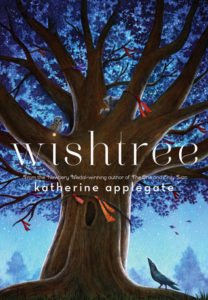
Wishtree – by Katherine Applegate
/* Starred Review */ Gr 4–8—Newbery Award—winning author Applegate meets high expectations in this tale told by a tree named Red, a red oak who is “two hundred and sixteen rings old.” Touching on religious bigotry and the environment, Applegate keeps the emphasis on her characters, the many animals and birds who find shelter in the tree’s branches all year round. (All the birds and animals have names and the power to talk, just like Red.) Around the first of May, people write down their wishes on pieces of cloth and hang them from the tree’s branches, giving Red a special place in the community. The pacing starts out slowly, with early chapters focused almost entirely on the natural world, but eventually readers meet the human at the novel’s center. Samar, a recent Muslim refugee, is lonely and in need of a friend. A nameless boy uses the tree to convey hateful messages to Samar and her family. The owner of the tree is tired of roots in the plumbing and hopes all the nastiness will disappear if the tree is cut down, having forgotten the story of her ancestors and the beginning of all the wishes. Red decides to intervene and ask for help from the animals and birds. Even those who shy away from books with talking animals will find this believable fantasy elegant and poignant. Widening the appeal is a sparse word count, making this a great choice for a family or classroom read-aloud and an inviting option for reluctant readers. VERDICT Another stunning effort from Applegate. This thoughtful read is a top choice for middle graders.—Carol A. Edwards, formerly at Denver Public Library –Carol A. Edwards (Reviewed 06/01/2017) (School Library Journal, vol 63, issue 6, p84)
/* Starred Review */ PreS-Gr 2—Britt tackles the metaphysical for the picture book crowd. Two (presumably) parent/child pairs approach a subway from different directions: an African American father and son and a light-skinned mother and daughter. The boy reads a book while riding a skateboard; the girl has a musical instrument case strapped to her back. As the kids notice each other, he wonders: “Why am I me …and not you?” She thinks: “Why are you, you…and not me?” And so it goes, with thoughts such as, “If someone else were me,/who would they be?/Someone lighter,/older,/darker,/bolder?” Alko and Quall’s acrylic, colored pencil, and collage scenes portray a diverse population within the train car and seen through its windows. People of varying skin colors, physical abilities, and styles play, watch sports, or perform or listen to music. The thought bubble questions arise naturally; they’re the kinds of things that would go through a child’s mind when observing differences. The climax is spread over four openings. It begins with a triptych in which the star on the boy’s shirt becomes a twinkle in his eye and then a glowing shape in the sky. After the girl’s eye sparkles, the boy reaches out, and their faces intersect in a Venn diagram of friendship. VERDICT Universal questions combine with richly layered, captivating compositions, presenting opportunities for careful examination and stimulating conversations. Perfect for classroom or one-on-one sharing.—Wendy Lukehart, District of Columbia Public Library –Wendy Lukehart (Reviewed 07/01/2017) (School Library Journal, vol 63, issue 7, p56)
 The Little Red Cat: who ran away and learned his ABCs (the hard way) – by Patrick McDonnell
The Little Red Cat: who ran away and learned his ABCs (the hard way) – by Patrick McDonnell
/* Starred Review */ PreS-Gr 1—McDonnell’s abecedarian tale takes a small scarlet cat on a breathtaking adventure. The clever tale—wordless except for two signs and one warning shout—begins when the feline notices his home’s front door standing open and takes to the hills. He almost immediately comes upon a gape-mouthed Alligator, a climbing Bear, and an agitated Chicken along with a couple of other pursuers of the D and E variety. A chase begins with the cat leading his entourage through a day filled with ice and snow, a jungle, mountain peaks, and a potentially hazardous tumble off a high cliff. Humorous pen, ink, pencil and watercolor illustrations surrounded by copious white space are energetic and highly engaging for readers. The large letters of the alphabet appear near the top of the page and feature both capital and lowercase forms. While most illustrations offer a clear-cut answer to what each letter represents in the sequence, there are a few pages that require some thought; an answer key can be found at the end of the book. VERDICT A brilliant caper that young learners will want to pore over! A must-purchase.—Maryann H. Owen, Children’s Literature Specialist, Mt. Pleasant, WI –Maryann H. Owen (Reviewed 08/01/2017) (School Library Journal, vol 63, issue 8, p74)
 When’s my Birthday? – by Julie Fogliano
When’s my Birthday? – by Julie Fogliano
Preschool-Grade 1 /* Starred Review */ In an infectious, bouncy rhythm, Fogliano playfully captures the antsy excitement for birthdays in a pitch-perfect kid voice. In between a refrain of “When’s my birthday? / Where’s my birthday? / How many days until / my birthday?” Fogliano’s verses cover food and presents, who to invite, and, of course, the all-important cake. Robinson’s thickly painted collage illustrations feature cheery children and friendly creatures in birthday hats, with always happy faces enjoying the delights described in Fogliano’s lines. Amid all the anticipation and happy planning, the text takes a realistically worried turn when the waiting seems so endless that the narrator wonders whether he or she will have a birthday at all. Luckily, after a near-sleepless night, the day finally arrives: “It’s the daytime! / Here’s my birthday! / Happy happy! / Hee! Hee! Hee!” Robinson’s signature style—bold collages depicting kids and animals in blocky shapes—is the ideal vehicle for Fogliano’s frolicsome text, and the two together evoke a quintessentially childlike glee, which adults will recognize and little ones will revel in. There might be a more perfect picture book about birthdays out there, but you’d be hard-pressed to find it. — Hunter, Sarah (Reviewed 7/1/2017) (Booklist, vol 113, number 21, p69)
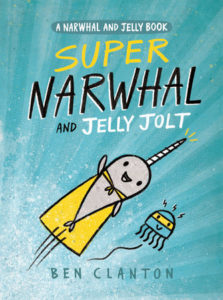 Super Narwhal and Jelly Jolt – by Ben Clanton
Super Narwhal and Jelly Jolt – by Ben Clanton
/* Starred Review */ Gr 1–3–Donning a cape, Narwhal decides to become a superhero—after eating lunch, of course. Super Narwhal needs a sidekick, so pal Jelly is dubbed Jelly Jolt. In this second installment of the sweetly surreal series, the characters are true to form; delightfully ditzy Narwhal remains upbeat even when he initially fails to exhibit a single superpower, while his jellyfish friend frets at every turn. In addition to three tales about Narwhal and Jelly, there’s a section about the “superpowers” of various ocean creatures (for instance, crabs can regrow their legs, the mimic octopus can change its appearance to resemble other animals, and dolphins sleep with one eye open) and a pun-laced story “written” by Narwhal and Jelly, in which Super Waffle and Strawberry Sidekick rescue their city from a giant butter blob. Clanton crafts a whimsical narrative that focuses on quirky conversations rather than superheroic adventures, and the funny story will snare a range of readers. Lively illustrations, dominated by hues of blue and featuring irresistibly cheerful characters, have a childlike feel, as though scribbled by a youngster clutching a crayon. As in many of the best reads starring dynamic duos—Arnold Lobel’s “Frog and Toad,” Mo Willems’s “Elephant and Piggie”—friendship is at the core; Narwhal always quells the many anxieties of his loyal companion. VERDICT A super addition to graphic novel collections serving younger readers, especially where the first volume is popular.—Mahnaz Dar, School Library Journal –Mahnaz Dar (Reviewed 06/01/2017) (School Library Journal, vol 63, issue 6, p83)
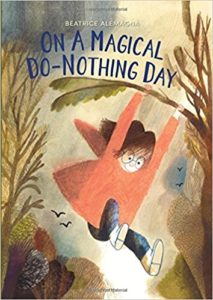 On a Magical Do-Nothing Day – by Beatrice Alemagna
On a Magical Do-Nothing Day – by Beatrice Alemagna
/* Starred Review */ While her mother works at her desk, a girl in owlish spectacles plays with a handheld video game console. “What about a break from your game?” her mother says, prodding the girl outside despite the pouring rain. Almost at once she drops her device in a pond (“This could not be happening to me”) and sinks into despair (“The rain felt like rocks were hitting me”). Then, in a moment of magic, she’s greeted by four cheerful snails, and her journey opens into an encounter with all the life of the forest: “a thousand seeds and pellets, kernels, grains, roots, and berries touched my fingers.” Alemagna’s spreads ignite with the warm glow of discovery. The generous trim size accommodates big, dramatic spreads as the girl, in her incandescent orange cape, tumbles down a hill and sees the world turned dizzily upside down. When she returns to the family’s cabin, the girl finds that even her mother looks a bit different now. Alemagna demonstrates an uncanny knack for rendering emotional experience with line and color in this intimate and distinctive story. Ages 4–8. (Sept.) –Staff (Reviewed 07/10/2017) (Publishers Weekly, vol 264, issue 28, p)
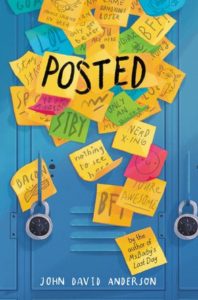 Posted – by John David Anderson
Posted – by John David Anderson
Grades 5-8 /* Starred Review */ By eighth grade, Frost feels secure within his established circle of smart, relatively geeky boys, including Bench, Deedee, and Wolf, who know they can count on one other. But Rose, a new student with a tall, muscular body and an independent streak, unexpectedly joins their table in the middle-school cafeteria. Then Bench starts hanging out with his fellow athletes instead of the gang. Meanwhile, a school-wide cell-phone ban leads to the increasingly “twitchy” student body writing their messages, jokes, opinions, and insults on sticky notes and slapping them on each other’s lockers for all to see. Bullying becomes more open, and matters come to a head when Rose challenges an intimidating middle-school thug to a suicidal bike race down a steep, wooded hillside. Written with understated humor and fine-tuned perception, Frost’s first-person narrative offers a riveting story as well as an uncomfortably realistic picture of middle-school social dynamics. The author of Ms. Bixby’s Last Day (2016), Anderson vividly portrays each boy in Frost’s group, their intertwined relationships, and their individual responses to the changes that inevitably come. Initially not well understood by the narrator, Rose gradually comes into focus as an individual and an agent of inevitable change. This rewarding novel should resonate with many readers. — Phelan, Carolyn (Reviewed 3/15/2017) (Booklist, vol 113, number 14, p64)
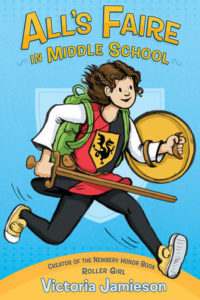 All’s Faire in Middle School – by Victoria Jamieson
All’s Faire in Middle School – by Victoria Jamieson
/* Starred Review */ Jamieson doesn’t disappoint in her first graphic novel since her Newbery Honor–winning Roller Girl. Imogen Vega’s parents perform at a Renaissance fair in Florida, immersing the family in a world of jousting and archaic language (“Thou qualling toad-spotted clack-dish!”). Imogen has been homeschooled all her life; now, at 11, she’s headed to public school. In her first weeks, she falls victim to the wiles of a mean girl, hurts a girl who might have been a good friend, and throws her younger brother’s treasured stuffed animal into the lake. As Imogen undergoes a period of self-enforced solitude, the extended family of the fair community offers unexpected support. Jamieson’s sturdy artwork (her figures are decidedly unglamorous, as if to offer regular kids reassurance) and sharp dialogue make it easy to care about her characters. Readers will also appreciate the irreverent humor of the fair’s adults: as a treatment for bullies, one recommends “a large quantity of chicken feathers and a few pots of honey.” The fair emphasizes adventure and theater, but its unconventional performers teach Imogen about kindness, too. Ages 9–12. Agent: Paul Rodeen, Rodeen Literary Management. (Sept.) –Staff (Reviewed 07/17/2017) (Publishers Weekly, vol 264, issue 29, p)
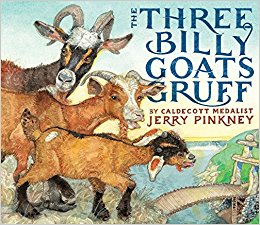 The Three Billy Goats Gruff – by Jerry Pinkney
The Three Billy Goats Gruff – by Jerry Pinkney
/* Starred Review */ PreS-Gr 2—Employing his signature pencil and watercolor compositions, Pinkney brings a thoughtful, nuanced perspective to this classic tale. The story begins as expected, with the goats “trip-trapping” across the bridge in search of food—the first two urging the troll to wait for the bigger animal coming next. Each goat has a distinctive appearance; the troll is fierce, with green skin, horns, and exceptionally large teeth. The halcyon, rainbow-studded river valley is surrounded with rocks on one side and lush vegetation on the other. While the story retains familiar cadences, subtle decisions about language and behavior elevate the telling, ensuring multiple readings. As the drama progresses, the design changes, incorporating ever-stronger personalities until a gatefold opening accommodates the standoff between the largest goat and the troll. Hand-lettered sound effects enhance the text’s dynamic potential. An artist’s note mentions that Pinkney was “confounded by the ending of the original tale, in which the troll disappears or turns to stone… It seemed he never had a chance to learn his lesson.” Here, after the troll is catapulted into the water, he faces a monster fish who gives him a taste of his own medicine. A visual epilogue on the endpapers allows readers to form their own conclusions about the encounter’s impact on all involved. –Wendy Lukehart (Reviewed 02/01/2017) (School Library Journal, vol 63, issue 02, p76)
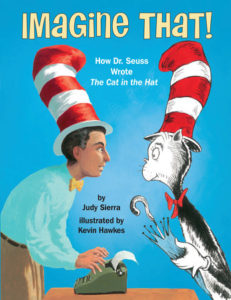 Imagine That! How Dr. Seuss Wrote The Cat in the Hat – by Judy Sierra
Imagine That! How Dr. Seuss Wrote The Cat in the Hat – by Judy Sierra
Gr 1–3—The 1950s was a boring time for beginning readers in the United States. After a critic wrote about the lack of fun books in this category, Seuss was determined to write one of his very own. Limited by the words that could be used for such a book, he created the classic The Cat in the Hat. Adults and children alike will enjoy reading about Seuss, his funny hats, and all the work that went into making one of the most well-known children’s book characters of all time. Hawkes adeptly uses Seuss-like illustrations to tell his story, incorporating famous Seussian words, characters, and the man himself throughout. Children will love to learn more about this renowned author and how he came up with such a simple but ingenious book. Educators could use this work for various writing activities and lessons. Also Sierra’s focus on how long it took Seuss to finish his masterpiece will communicate to young readers the stamina it takes to create. VERDICT An easy addition to any elementary school nonfiction collection.—Molly Dettmann, Moore Public Library, OK –Molly Dettmann (Reviewed 09/01/2017) (School Library Journal, vol 63, issue 9, p165)

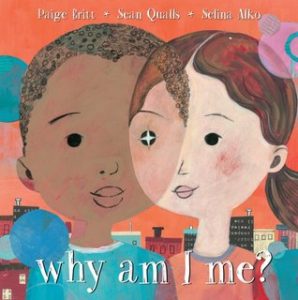 Why I am me! – by Britt Paige
Why I am me! – by Britt Paige